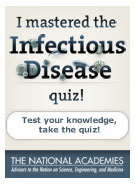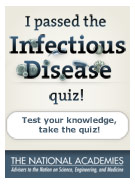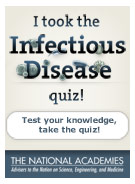
What You Need To Know About Infectious Disease
What do you know about infectious disease?
Which of the following is an effective way to protect yourself against infectious disease?
- Keep immunizations up to date
- Wash your hands often
- Prepare and handle food carefully
- All of the above
-
Sorry, that’s incorrect.
All of the above can help prevent infectious disease. Other behaviors, such as exercising caution around wild and unfamiliar domestic animals, avoiding insect bites, practicing safe sex, and being vigilant about disease threats while traveling abroad, can also reduce the risk of infection.
-
Sorry, that’s incorrect.
All of the above can help prevent infectious disease. Other behaviors, such as exercising caution around wild and unfamiliar domestic animals, avoiding insect bites, practicing safe sex, and being vigilant about disease threats while traveling abroad, can also reduce the risk of infection.
-
Sorry, that’s incorrect.
All of the above can help prevent infectious disease. Other behaviors, such as exercising caution around wild and unfamiliar domestic animals, avoiding insect bites, practicing safe sex, and being vigilant about disease threats while traveling abroad, can also reduce the risk of infection.
-
Correct!
All of the above can help prevent infectious disease. Other behaviors, such as exercising caution around wild and unfamiliar domestic animals, avoiding insect bites, practicing safe sex, and being vigilant about disease threats while traveling abroad, can also reduce the risk of infection.
True or False: The only way public health agencies can deal with infectious disease is to have good surveillance in place, wait for an outbreak to happen in a human population, and then rush to contain it.
-
Sorry, that’s incorrect.
By identifying pathogens in the animals where they naturally live and monitoring those organisms as they move from animals into people, it may be possible to prevent deadly new infections of animal origin from entering and racing through human populations.
-
Correct!
By identifying pathogens in the animals where they naturally live and monitoring those organisms as they move from animals into people, it may be possible to prevent deadly new infections of animal origin from entering and racing through human populations.
Roughly how many microbes live in the human gastrointestinal tract?
-
Sorry, that’s incorrect.
About ten trillion microbes live in the human gastrointestinal tract. They are essential for proper digestion and absorption of nutrients.
-
Sorry, that’s incorrect.
About ten trillion microbes live in the human gastrointestinal tract. They are essential for proper digestion and absorption of nutrients.
-
Sorry, that’s incorrect.
About ten trillion microbes live in the human gastrointestinal tract. They are essential for proper digestion and absorption of nutrients.
-
Correct!
About ten trillion microbes live in the human gastrointestinal tract. They are essential for proper digestion and absorption of nutrients.
True or False: If you have a cold or the flu, taking antibiotics will help treat the infection.
-
Sorry, that’s incorrect.
Antibiotics only work on bacterial infections, not viral infections such as influenza and the common cold. In fact, inappropriate use and overuse of antibiotics contributes to the emergence of drug-resistant bacteria.
-
Correct!
Antibiotics only work on bacterial infections, not viral infections such as influenza and the common cold. In fact, inappropriate use and overuse of antibiotics contributes to the emergence of drug-resistant bacteria.
The human papillomavirus (HPV) causes about what percentage of cervical cancer cases?
-
Sorry, that’s incorrect.
The human papillomavirus (HPV) causes more than 90% of cervical cancer cases.
-
Sorry, that’s incorrect.
The human papillomavirus (HPV) causes more than 90% of cervical cancer cases.
-
Correct!
The human papillomavirus (HPV) causes more than 90% of cervical cancer cases.
How many people in the United States die from flu-related complications each year?
-
Sorry, that’s incorrect.
About 36,000 people die from flu-related complications each year in the United States. More than 200,000 are hospitalized.
-
Correct!
About 36,000 people die from flu-related complications each year in the United States. More than 200,000 are hospitalized.
-
Sorry, that’s incorrect.
About 36,000 people die from flu-related complications each year in the United States. More than 200,000 are hospitalized.
Which are larger?
-
Correct!
Bacteria are 10 to 100 times larger than viruses.
-
Sorry, that’s incorrect.
Bacteria are 10 to 100 times larger than viruses.
Which are examples of ways that pathogens (disease-causing microbes) can spread?
- Coughing
- Eating undercooked pork
- Flea bite
- Breathing dust particles containing microorganisms
- All of the above
-
Sorry, that’s incorrect.
All are examples of ways that pathogens can spread. Coughing is an example of airborne droplet transmission; eating undercooked pork is an example of common vehicle transmission; a flea bite is an example of vector transmission; and breathing contaminated dust particles is an example of airborne transmission.
-
Sorry, that’s incorrect.
All are examples of ways that pathogens can spread. Coughing is an example of airborne droplet transmission; eating undercooked pork is an example of common vehicle transmission; a flea bite is an example of vector transmission; and breathing contaminated dust particles is an example of airborne transmission.
-
Sorry, that’s incorrect.
All are examples of ways that pathogens can spread. Coughing is an example of airborne droplet transmission; eating undercooked pork is an example of common vehicle transmission; a flea bite is an example of vector transmission; and breathing contaminated dust particles is an example of airborne transmission.
-
Sorry, that’s incorrect.
All are examples of ways that pathogens can spread. Coughing is an example of airborne droplet transmission; eating undercooked pork is an example of common vehicle transmission; a flea bite is an example of vector transmission; and breathing contaminated dust particles is an example of airborne transmission.
-
Correct!
All are examples of ways that pathogens can spread. Coughing is an example of airborne droplet transmission; eating undercooked pork is an example of common vehicle transmission; a flea bite is an example of vector transmission; and breathing contaminated dust particles is an example of airborne transmission.
The 1918 influenza pandemic (the so-called “Spanish” flu) is estimated to have killed how many people worldwide?
-
Sorry, that’s incorrect.
The 1918 influenza pandemic is estimated to have killed between 50 million and 100 million people worldwide. Many of those deaths were due to the effects of pneumococcal pneumonia, a secondary complication of flu for which no antibiotics existed in 1918.
-
Sorry, that’s incorrect.
The 1918 influenza pandemic is estimated to have killed between 50 million and 100 million people worldwide. Many of those deaths were due to the effects of pneumococcal pneumonia, a secondary complication of flu for which no antibiotics existed in 1918.
-
Correct!
The 1918 influenza pandemic is estimated to have killed between 50 million and 100 million people worldwide. Many of those deaths were due to the effects of pneumococcal pneumonia, a secondary complication of flu for which no antibiotics existed in 1918.
Thank you for taking our quiz.
Place this badge on your Facebook page to show your friends what you know about infectious disease.
Place this badge on your Facebook page to show your friends what you know about infectious disease.
OR, get a higher score to unlock a different badge.
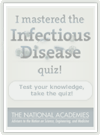
Place this badge on your Facebook page to show your friends what you know about infectious disease.
OR, get a higher score to unlock a different badge.
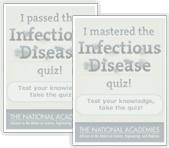
Explore Other Topics
Disease Watchlist
Infectious Disease Defined
- Climate Change
The process of shifting from one prevailing state in regional or global climate to another. Climate change is typically the preferred term over “global warming” because it helps to convey that the characteristics of climate change are not limited to rising temperatures.
